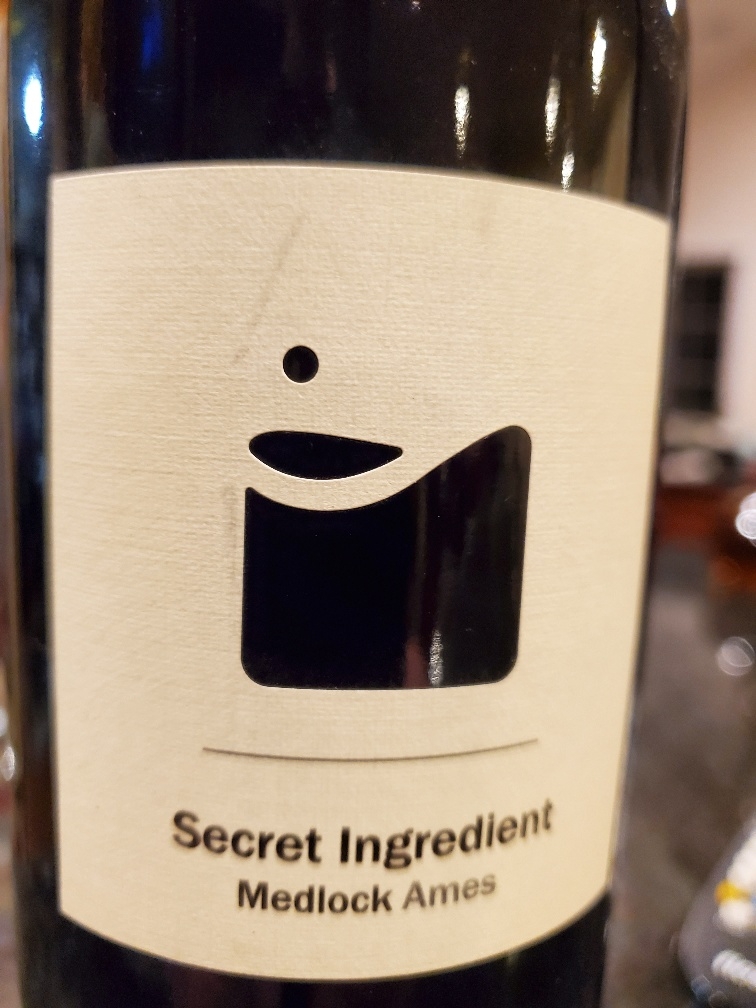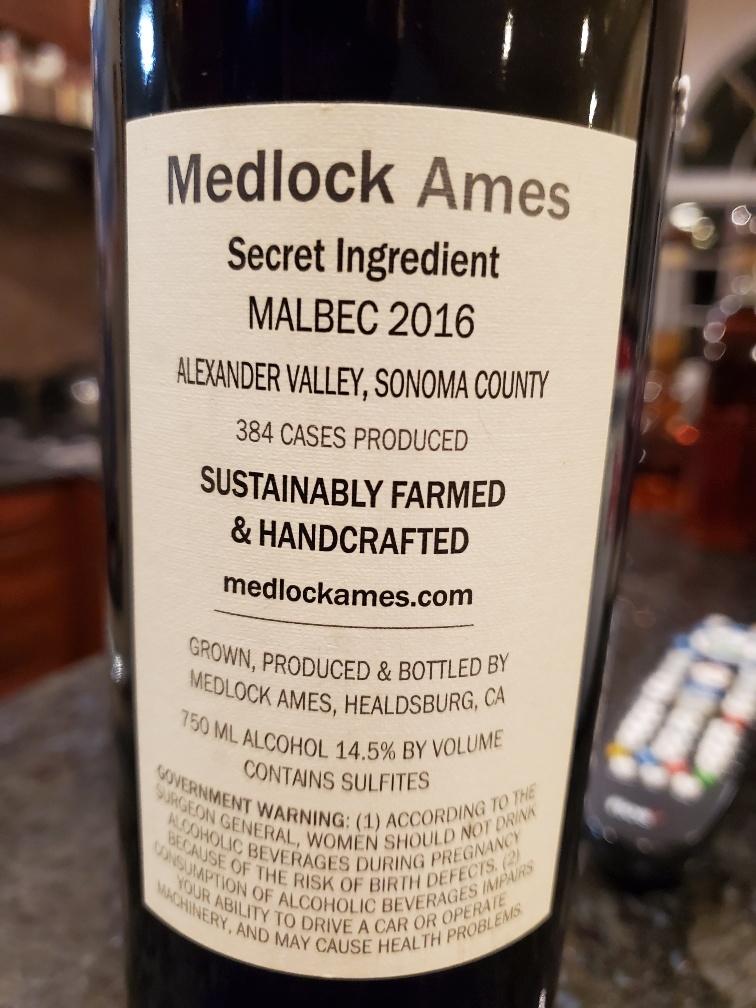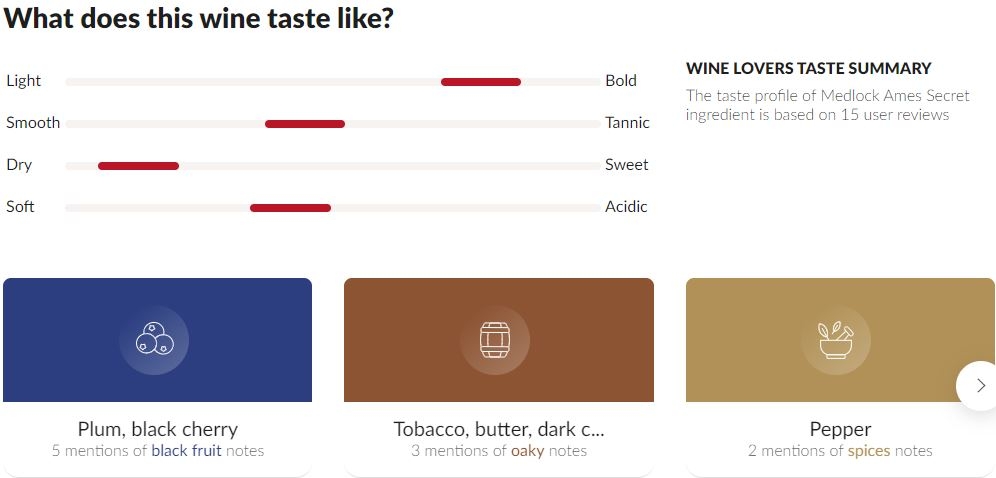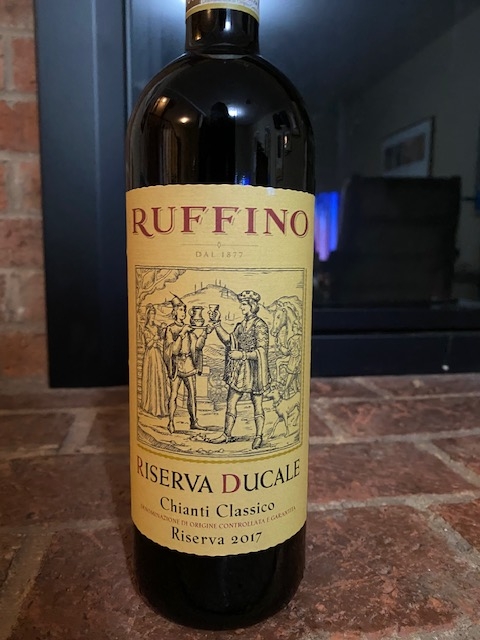Welcome to the Wine Lovers Forum. We have several categories for discussion topics and you should select the most appropriate one if you choose to create a new discussion topic. This forum is hosted by Big Al; if you need assistance, please message him or send an e-mail to 'bigal01@gmail.com'. Enjoy yourself, and of course we recommend you have a glass of wine nearby.
Howdy, Stranger!

Comments
The Barolo is something different for us. I may have had it at one of our wine tastings (Italian wines) that Allen ran at the house.
Kathleen brought a nice wine too! Medlock Ames Secret Ingredient 2017 ,A Malbec



2017 Ruffino Riserva Ducale Chianti Classico
Noble Grape: Sangiovese
I opened it about 15 minutes ago. I'll give it a few more minutes before I taste it.
Sangiovese
Sangiovese is Chianti’s heart and hero. Its calling card is mouthwatering acidity, a transparent ruby hue and flavors of black and red cherry. Further accents of violets, herbs, spice and earth are common in this dry red. Moderate tannins increase with quality, as does structure and body, which progresses from light to medium. Chianti rarely achieves the body and density of its Sangiovese-based cousin Brunello further south in Montalcino.
Chianti Classico, Chianti and its Subzones
Like all Italian wines, Chianti comes with rules. And like all Italian rules, they are frequently confusing. There are several categories of “Chianti.” There’s Chianti, which is the catchall appellation at the bottom of the quality pyramid; Chianti Classico, which has its own appellation; and Chianti Rufina and Chianti Colli Senesi, subzones of Chianti known for their high-quality bottlings.
Chianti Classico DOCG
This appellation is located in the heart of the broader Chianti region. The boundaries were first defined in the 18th century, but enlarged significantly in the 1930s. This move was thought by many to have damaged the brand’s reputation, though such expansion is common across Italian wine regions.
Today, Chianti Classico DOCG is considered by many to be the highest-quality offering for Chianti.
The emblem of Chianti Classico is the black rooster, or gallo nero. It relates to a legend told about the use of roosters to settle a border dispute between the warring provinces of Sienna and Florence. The black cockerel was the symbol of Florence, while the white cockerel represented Sienna. It’s clear who dominated that contest.
Marked by refreshing acidity, Chianti Classico DOCG grapes come typically from vineyards planted at higher elevations than Chianti DOCG. Flavors include violet and spice layered atop juicy cherry. Tannins and structure increase with quality, but reflect fruit and terroir rather than oak. New oak, which can slather wine in baking spice and vanilla, has mostly been abandoned. Traditional large oak casks are now preferred, which lend greater transparency to wines.
Chianti Classico DOCG Nine Communes
Barberino Val d’Elsa
Castellina in Chianti
Castelnuovo Berardenga
Gaiole in Chianti
Greve in Chianti
Poggibonsi
Radda in Chianti
San Casciano Val di Pesa
Tavernelle Val di Pes
Chianti Classico must contain at least 80% Sangiovese. A maximum of 20% of other red grapes Colorino, Canaiolo Nero, Cabernet Sauvignon and Merlot may be used. White grapes were banned in 2006.
There are three quality tiers in the appellation. Annata, or the standard wine, ages for 12 months before release, while Riserva must age 24 months. Gran Selezione has the longest aging requirement at 30 months.
In February 2014, the first top-tier Gran Selezione wines debuted from the 2010 vintage. The category also requires estate-grown grapes and approval from a tasting panel.
Chianti Classico is divided into nine communes. In Siena province: Radda in Chianti, Gaiole in Chianti, Castellina in Chianti, Castelnuovo Berardenga, Poggibonsi. In Florence province: Greve in Chianti, Barberino Val d’Elsa, San Casciano Val di Pesa, Tavernelle Val di Pesa. Though labeling by commune is not yet allowed, wines still reflect distinctions in soil and microclimate, thus further divisions may appear in the future.
First impression of my wine, and to remind folks, here is the picture, again
This is an interesting wine. Initial tongue sensation is salinity--something that I occasionally find in Syrah. Then, I get a light hit of dark berry--something that I often find in Napa Valley Cabernet Sauvignon, but not nearly as intense. Some dustiness. Nice tannin structure.
It will be interesting to compare this Malbec with Kathleen's Alexander Valley example.
OK, my wine has gone through a 90 minute session in the decanter following aeration. It is time to test (first sip to check for wine fault two hours back doesn't count). You'll need to go back quite a few posts to my write-up on the wine, grape variety and region, if interested. The pictures are posted there as well. Anyway, here is the review:
"The Grand Vin of Chateau Montus for 2014 is opaque black-cherry in the glass, a result, no doubt, of its 80% Tannat component. It gives forth a wonderful, spicy raspberry-plum nose that tickles the nostrils. Inviting. Entry has raspberry and cassis mid-palate, with a density for the ages; tannin is richly evident, though integrating well with the ample backbone of red and black fruit. Finish is long, sweet and slightly poignant indicative of years (perhaps a decade) left for cellaring - if you can wait. This is the best Madiran I have ever tasted. I shall be back for more. 93. 4.5 glasses."
Oh, I see the party has started across the country now.
Our Moscato was actually quite delicious and I give it a 4 glasses assessment - pretty good for an off-dry white wine.
Meanwhile, we just grilled our dinner entree - ribeye steak. It was paired with potato and snow peas, but also another wine. This wine is of course a noble grape too, the Cabernet Sauvignon. Let me introduce you to the 2015 Force Majeure Cabernet Sauvignon.

Robert Parker: The 2015 Estate Cabernet Sauvignon is a big, ripe, chewy effort offering loads of blackcurrants, licorice, scorched earth and chocolate. It’s undeniably Red Mountain in style yet, like all the wines here, is impeccably made. I suspect short term cellaring will be beneficial, but this baby has fruit! Rating 93-95.
Force Majeure: It is both passion and obsessive attention to detail that push Force Majeure to raise the standard for Washington winegrowing. Inspired by the vineyards of Bordeaux, Hermitage, Priorat, and Cote Rotie, we challenged existing viticultural practices and embarked on an ambitious plan to pioneer the very first vineyard on the steep, upper slopes of Red Mountain.
This Herculean effort involved the careful matching of varietal and clonal selections, trellising and irrigation to the nine distinct soil types formed by the ancient Missoula floods, winds and volcanic activity. The outcome is a vineyard articulated into many small "micro-blocks," to meet the management demands of this unique and dynamic site. Due to the rough, rocky nature of the acreage and elevations ranging from 960 to 1,230 feet, mechanization is virtually impossible in the upper portion of Force Majeure, requiring true "farming by hand." Yet the lower blocks of the vineyard are comprised of deep, well-drained Warden soils.
Thus, the diversity of our vineyard results in a versatility that allows us to grow a variety of compelling fruit characterized by stunning intensity, depth and concentration, complex flavors and fine tannins. We nurture a variety of Bordeaux and Rhone varietals at this special site and look forward to sharing, quite literally, the "fruits of our labor" with you.
A coveted source of top quality red grapes among premier Washington producers, the Red Mountain AVA is actually the smallest appellation in the state. As its name might suggest, it is actually neither a mountain nor is it composed of red earth. Instead the appellation is an anticline of the Yakima fold belt, a series of geologic folds that define a number of viticultural regions in the surrounding area. It is on the eastern edge of Yakima Valley with slopes facing southwest towards the Yakima River, ideal for the ripening of grapes. The area’s springtime proliferation of cheatgrass, which has a reddish color, actually gives the area the name, "Red" Mountain.
Red Mountain produces some of the most mineral-driven, tannic and age-worthy red wines of Washington and there are a few reasons for this. It is just about the hottest appellation with normal growing season temperatures commonly reaching above 90F. The soil is particularly poor in nutrients and has a high pH, which results in significantly smaller berry sizes compared to varietal norms. The low juice to skin ratio in smaller berries combined with the strong, dry summer winds, leads to higher tannin levels in Red Mountain grapes.
The most common red grape varieties here are Cabernet Sauvignon, Merlot, Cabernet Franc and Syrah, among others. Limited white varieties are grown, namely Sauvignon blanc.
The reds of the area tend to express dark black and blue fruit, deep concentration, complex textures, high levels of tannins and as previously noted, have good aging capabilities.
A note on QTP for Madiran. This wine compares with wines from Bordeaux (or Paso Robles) that are more than twice the price. If you look, you may be able to find a 2010-2014 vintage range for about 35 US plus tax. I'll be back later to look through the wines submitted for discussion. They look delicious.
Maybe someday I'll taste a Tannat wine that I like.
Paul Burt has asked me to post a few things for you. Here are his posts concerning his drinking preferences tonight:
First.
Second.
And some more... perhaps his drinking range tonight...
Here's the 2nd post -
In no particular drinking order
And thanks again - tomorrow I'll send the #2 & #3 in our WOTY count down.
Paul
Ruffino Chianti Classico. It needs to breath a bit longer, but I have all night. Initial impressions... cherry, a hint of of prune, earthy spice, pepper-y, dry smooth finish. Rating 3.5. I expect the score to increase the longer it's exposed to air.
Ditto on Tannat for us. They aren't bad but aren't enjoyable enough for us to purchase again with so many other options!
Subsequent sips of the Clos Pegase Malbec have shown a retro-nasal meatiness--think raw hamburger. Not offensive, at all, and definitely interesting.
Good body. Good Mouthfeel.
Acid is starting to build.
So far, a very enjoyable wine.
FWIW, my noshes while I have been sipping have been darned similar to Al's. I think that, later, we will be having Pita Bread Pizzas off the grill.
Raw hamburger? Interesting.
SZ, thanks for posting the stuff for Paul. I hope he can resolve his connectivity issues this week.
Taste is one of the random selectors of human individuality. But you should look for the higher end products if you ever venture into Tannat territory again (Chateau Montus is certainly worth a try, if you haven't tried it - or Garzon from Uruguay, or Tablas Creek in Paso Robles). But I'll let you all in on a secret: My favourite red wine is blended Bordeaux, so you know that does not include Tannat. If I can get it, I will take Pinot Noir over anything else, but that finicky grape just loves to disappoint. Oregon and Nuits-Saint-Georges can reach for the heavens though...
I truly hope PB can return to this forum soon.
It looks like he is joining Lynn in Tuscany, tonight.
Hey @BigAl , Force Majure is cheating... when it comes to Cab.
I call 'em as I see 'em.
Our 2nd wine this evening - 2012 Tablas Creek Tannat (Paso Robles).
In a word - delicious!
The Tablas Creek Vineyard 2012 Tannat is Tablas Creek’s tenth bottling of this traditional varietal from South-West France, known principally in the Pyrenees foothills appellation of Madiran, but originally native to the Basque region. The Tannat grape has intense fruit, spice, and tannins that produce wines capable of long aging, and it is traditionally blended with Cabernet Sauvignon or Cabernet Franc.
The 2012 Tannat shows a dense purple-black color and has a nose of blue and black fruit, mineral, smoke, game herbs (sage and juniper), and spice. The rich palate has flavors of black cherry, smoked meat, and bittersweet chocolate with big but ripe tannins and a long, smoky, generous finish. We believe that it will drink well for a decade or more.
ACCOLADES
91-93 points; "extroverted...intense personality": Antonio Galloni (July 2014)
BLEND
91% Tannat
9% Cabernet Sauvignon
TECHNICAL NOTES
14.1% Alcohol by Volume
980 Cases Produced
I'm really liking my wine.
Have I been wrong about Malbec all these years?
Cheating? It’s one of the best wines in our cellar.
Going downstairs, now, I'll get caught up tomorrow.
I have to say, though, it has been fun, tonight.
Kathleen's Medlock Ames Malbec has a very light tannin structure. Its very smooth and just a little on the drier side but very enjoyable. Definite dark fruits like Plum Black Cherry and Black raspberry. Really a beautiful dark purple/magenta color that has a nice finish! 4 1/2 glasses
Some good wines tonight. That 2012 Tablas Creek Tannat must have been in Vin0Vin0’s wine cellar a few years.
@BigAl Force Majeure is one WA's best, and difficult to come by, so of course you are cheating. There are not many Cabs better than this one for the price. But I am not commenting on your taste, just saying the rest of us are (probably) envious.
Al, because Tannat is known to need time on its side to resolve those ferocious tannins. I've been letting this one set since early 2015. It was worth the wait.
SZ, fyi, I paid $32 for this back in '15.
So I was right. Ha! Second time this week.
I like the many different wines showing here. The Tablas Creek is one I have been trying to obtain for some time and I am glad VV reviewed a mature example. It sounds like a face-to-face (vis-a-vis?) tasting with the Montus from Madiran would have been splendid.
I realize in making these remarks it seems, well, Tannat-centric, but sometimes it is good to front an underrated, undervalued grape. As for Barolo, well, if you like those powerful Nebbiolo wines, you should be able to appreciate Tannat (at 7 years plus), but I admit to differences between the grapes.
As for Malbec, well, it can be extremely good - in the hands of the right winemaker. Apparently, some of you rediscovered this grape tonight and it is worth rediscovery. I just have not had the time or the capacity of late to experiment with it. If you are interested in the grape, which once was important in Bordeaux, you might try a high end Cahors (France) example for comparison.